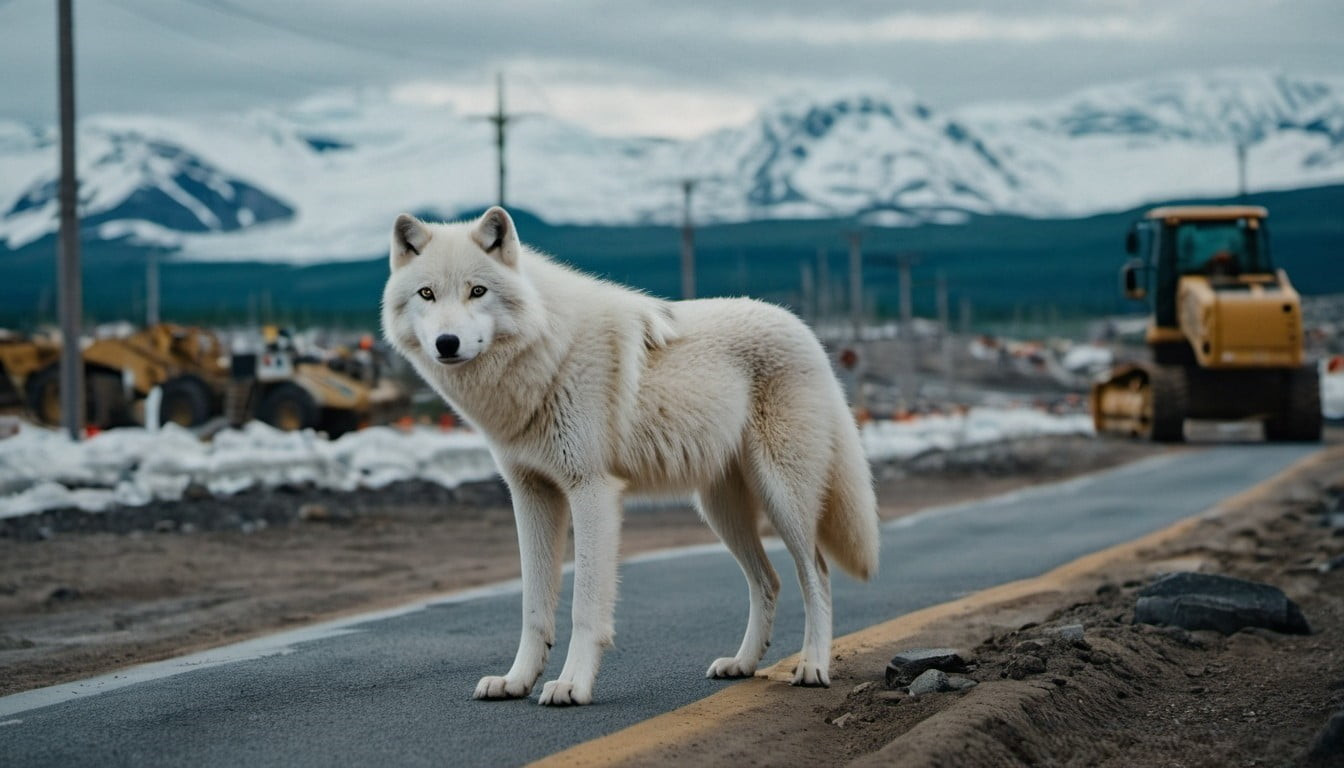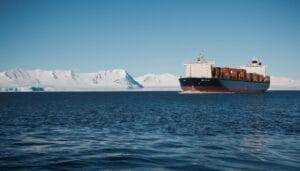Introduction
Road and infrastructure developments pose significant threats to the habitats of Arctic wolves, leading to various ecological disruptions
This article explores the impacts these developments have on Arctic wolf habitats, including hunting pattern disruptions, habitat fragmentation, and changes in prey availability. It also examines the long-term effects on wolf populations, adaptations to environmental changes, and mitigation measures to protect these critical habitats
Impact of Roads and Infrastructure on Arctic Wolf Habitats
Roads and infrastructure developments in the Arctic are increasingly encroaching upon the natural habitats of Arctic wolves. These developments pose several challenges for the wolves, affecting their hunting patterns, fragmenting their habitats, and altering the availability of their prey:
Disruption of Hunting Patterns
Arctic wolves rely heavily on their ability to roam vast, undisturbed landscapes to hunt for prey such as caribou, musk oxen, and Arctic hares. The construction of roads and other infrastructure can disrupt these hunting patterns in several ways:
Physical Barriers: Roads can act as physical barriers, preventing wolves from accessing certain hunting grounds or forcing them to take longer, more energy-intensive routes
Behavioral Changes: The presence of roads and increased human activity can cause wolves to change their hunting behaviors, leading them to avoid certain areas altogether. This can result in less efficient hunting and reduced food intake
Mortality Risk: Wolves crossing roads face the risk of vehicular collisions, which can lead to direct mortality and reduce the overall population
Habitat Fragmentation
One of the most significant impacts of infrastructure development is habitat fragmentation. This occurs when continuous habitats are divided into smaller, isolated patches. For Arctic wolves, this fragmentation can have several detrimental effects:
Reduced Territory: Wolves require large territories to support their packs and provide sufficient prey. Fragmentation can reduce the size of available territories, leading to increased competition among wolves and other predators
Genetic Isolation: Smaller, isolated populations are more susceptible to genetic bottlenecks, which can reduce genetic diversity and increase the risk of inbreeding. This can result in weaker populations that are less adaptable to environmental changes
Interference with Migration: Many of the prey species that Arctic wolves depend on, such as caribou, are migratory. Infrastructure developments can interfere with these migration routes, making it harder for wolves to find food
Effects on Prey Availability
Infrastructure development not only affects Arctic wolves directly but also impacts the availability of their prey. Key prey species can be affected in various ways:
Habitat Loss for Prey: As roads and infrastructure encroach on the habitat of prey species, these animals may experience reduced food availability and increased competition for resources
Altered Migration Patterns: Infrastructure can disrupt the natural migration patterns of prey species, making them less predictable and harder for wolves to hunt
Increased Human Activity: The presence of humans and the noise associated with construction and traffic can drive prey species away from their natural habitats, reducing the number of available prey for wolves
Noise and Human Activity
The noise and increased human activity associated with roads and infrastructure developments can have several adverse effects on Arctic wolves:
Stress and Behavioral Changes: Continuous noise and the presence of humans can cause stress and anxiety in wolves, leading to changes in their natural behaviors, including hunting and social interactions
Avoidance of Developed Areas: Wolves may avoid areas with high levels of human activity, further reducing the size of their usable habitat. This avoidance behavior can force wolves into less suitable habitats, where food and shelter may be less abundant
Long-term Effects and Mitigation Measures
The long-term impacts of road and infrastructure development on Arctic wolf habitats extend beyond immediate disruptions. Understanding these effects and implementing effective mitigation measures are crucial for the conservation of Arctic wolves
Types of Infrastructure
Various types of infrastructure can impact Arctic wolf habitats, including:
Roads and Highways: These are the most common forms of infrastructure and can cause significant habitat fragmentation and direct mortality due to vehicle collisions
Oil and Gas Facilities: Extraction sites and associated infrastructure, such as pipelines, can disrupt large areas of habitat and introduce pollutants into the environment
Urban Development: Expansion of human settlements into Arctic regions can lead to permanent loss of habitat and increased human-wildlife conflicts
Mining Operations: Mining activities can lead to habitat destruction, pollution, and increased human presence, all of which negatively impact Arctic wolves
Long-term Population Effects
The long-term effects of infrastructure development on Arctic wolf populations can be severe:
Population Decline: Habitat fragmentation and reduced prey availability can lead to a decline in wolf populations as they struggle to find sufficient food and territory
Reduced Reproductive Success: Stress and environmental changes can affect the reproductive success of Arctic wolves, leading to fewer pups and lower population growth rates
Altered Pack Dynamics: Changes in habitat and prey availability can disrupt pack structures and social dynamics, potentially leading to increased aggression and competition within and between packs
Increased Human-Wildlife Conflicts: As wolves encroach on human settlements in search of food, conflicts between humans and wolves are likely to increase, often resulting in the lethal control of wolves
Arctic Wolf Adaptations to Changes
Despite the challenges posed by infrastructure development, Arctic wolves have shown some ability to adapt to changes in their environment:
Behavioral Flexibility: Wolves may alter their hunting strategies and travel routes to avoid roads and human activity. They may also adapt by expanding their diet to include a wider range of prey species
Utilization of Man-Made Structures: In some cases, wolves have been observed using man-made structures, such as bridges and culverts, to cross barriers safely. This behavior indicates a level of adaptability to fragmented habitats
Increased Nocturnal Activity: To avoid human activity, wolves may become more nocturnal, hunting and traveling primarily at night when human presence is minimal
Mitigation Measures
To reduce the impact of infrastructure development on Arctic wolf habitats, several mitigation measures can be implemented:
Wildlife Corridors: Establishing wildlife corridors can help maintain connectivity between fragmented habitats, allowing wolves and other wildlife to move freely and access necessary resources
Road Crossing Structures: Installing overpasses and underpasses specifically designed for wildlife can reduce the risk of vehicle collisions and facilitate safe crossings for wolves
Buffer Zones: Creating buffer zones around critical habitats and migration routes can minimize the intrusion of human activity and infrastructure development
Regulated Development: Implementing strict regulations on the location and extent of infrastructure projects can help protect sensitive habitats. Environmental impact assessments should be mandatory for all major projects
Community Education: Educating local communities about the importance of Arctic wolves and the impact of infrastructure development can foster support for conservation efforts and reduce human-wildlife conflicts
Conservation Efforts
Several conservation efforts are underway to protect Arctic wolf habitats from the negative impacts of infrastructure development:
Protected Areas: Establishing and expanding protected areas can ensure that large tracts of habitat remain undisturbed and available for Arctic wolves and other wildlife
Research and Monitoring: Ongoing research and monitoring of Arctic wolf populations and their habitats can provide valuable data to inform conservation strategies and track the effectiveness of mitigation measures
Collaboration with Indigenous Communities: Working with Indigenous communities, who have a deep understanding of the Arctic ecosystem, can enhance conservation efforts and ensure that development projects consider the needs of both wildlife and local people
International Cooperation: Given the transboundary nature of Arctic wolf populations, international cooperation is essential to implement cohesive conservation strategies across different countries and regions
Conclusion
The impact of road and infrastructure developments on Arctic wolf habitats is multifaceted, posing significant challenges to these majestic animals. Roads and other infrastructure lead to habitat fragmentation, disrupt hunting patterns, and reduce prey availability, all of which can have dire consequences for Arctic wolf populations
The long-term effects include population declines, altered pack dynamics, and increased human-wildlife conflicts. However, Arctic wolves have shown some adaptability, adjusting their behaviors and utilizing man-made structures to navigate their changing environment
Mitigation measures, such as wildlife corridors, road crossing structures, buffer zones, and regulated development, are crucial for minimizing the negative impacts of infrastructure projects
Conservation efforts, including the establishment of protected areas, research and monitoring, collaboration with Indigenous communities, and international cooperation, play a vital role in preserving Arctic wolf habitats
By understanding the specific impacts and implementing targeted strategies, we can help ensure the survival and well-being of Arctic wolves amidst ongoing development in their natural habitats











